Evaluation of p27 Expression in Salivary Gland Neoplasms; A Step Forward in Unveiling the Role of p27
Nikhil I. Malgaonkar1, Abdulwahab Abuderman2, MY Kharma3, SA Al-Maweri4, NA Alaizari5, MA. Altamimi6, S. Darwish7, Bassel Tarakji8
1 Faculty, Department of Oral Medicine and Diagnostic Sciences, Al Farabi Colleges, Riyadh, Saudi Arabia.
2 Faculty, Department of Basic Medical Sciences, College of Medicine, Prince Stam Bin Abdulaziz university.
3 Faculty, Department of Oral Maxillofacial Surgery, Al-Farabi Colleges, Aleppo University, Jeddah, Kingdom of Saudi Arabia.
4 Faculty, Department of Oral Medicine and Diagnostic Sciences, Al Farabi Colleges, Riyadh, Saudi Arabia.
5 Faculty, Department of Oral Medicine and Diagnostic Sciences, Al Farabi Colleges, Riyadh, Saudi Arabia.
6 Faculty, Department of Oral Medicine and Diagnostic Sciences, Al Farabi Colleges, Riyadh, Saudi Arabia.
7 Faculty, Department of Oral Medicine and Diagnostic Sciences, Al Farabi Colleges, Riyadh, Saudi Arabia.
8 Faculty, Department of Oral Medicine and Diagnostic Sciences, Al Farabi Colleges, Riyadh, Saudi Arabia.
NAME, ADDRESS, E-MAIL ID OF THE CORRESPONDING AUTHOR: Dr. Bassel Tarakji, Faculty, Department of Oral Medicine and Diagnostic Sciences, Al Farabi Colleges, Riyadh, Saudi Arabia.
E-mail: basseltarakji@yahoo.com
Introduction
Salivary gland neoplasms are not uncommon lesions that are seen in the head and neck region. The role of cell cycle regulators as well as that of oncogenes remains unexplored in the pathogenesis of these neoplasms.
Aim
Present study was conducted to evaluate the expression of p27 in the three common salivary gland neoplasms.
Materials and Methods
A total of 34 cases (19 pleomorphic adenoma, 8 mucoepidermoid carcinoma and 7 adenoid cystic carcinoma) were included. The divtions were subjected to p27 staining and rated for the expression.
Results
Of the total 52.6% of pleomorphic adenoma cases, 25% of mucoepidermoid carcinoma cases and only 14.2% of adenoid cystic carcinoma cases showed strong expression suggesting variable p27 expression in both malignant neoplasms. Normal salivary gland tissue was stained as a positive control for the evaluation.
Conclusion
The results of the study suggest an important role for p27 in pathogenesis of mucoepidermoid carcinoma as well as adenoid cystic carcinoma while its role in pathogenesis of pleomorphic adenoma remains questionable keeping in view the strong expression of p27 in the same.
Adenoid cystic carcinomas,Cyclin dependent kinase inhibitor,Mucoepidermoid carcinomas,Pleomorphic adenomas
Introduction
Salivary glands perhaps present with the most histologically heterogeneous group of tumors and greatest variety of morphologic features among their cells and tissues out of all the tissues in the human body [1]. Histopathogenesis as well as the genetic profiling of the benign as well as malignant salivary gland neoplasms has always been a fascinating topic for specialists of head and neck pathology and medicine. It is an established fact by now that aberrations in cell cycle at various stages form the mainstay of aetiology and progression of majority of the tumors affecting the human race [2]. Analysing the expression of various tumor suppressor genes, proto oncogenes as well as Cyclin Dependent Kinase Inhibitors (CDKIs) in the tumor tissues have helped in solving the puzzles of genetic aberrations associated with benign and malignant tumors. One family of CDKIs which comprises three proteins, namely CDKN1A (p21), p27 and p57, inhibits the CDKs broadly, whereas the other family of CDKIs has selective effects on cyclin D/CDK4 and cyclin D/CDK6 [2]. Although p27, a major CDK inhibitor, has been studied extensively in relation to melanoma and many other malignancies, its expression in salivary neoplasms, benign as well as malignant has not been explored and the study of this significant marker in relation to salivary neoplasms can give a new insight into the genetic etiopathogenesis of this group of tumors. This study has been conducted to gauge the expression of p27 in the three commonly reported salivary gland neoplasms viz. pleomorphic adenoma, mucoepidermoid carcinoma and adenoid cystic carcinoma. Conventionally, p27 has been known to be expressed in lesser amounts and intensity as the grade of the tumor rises. Few studies aiming at establishing a direct or an indirect correlation between prognosis of the tumor (other than of salivary gland origin) and expression of p27 have been reported [3–5]. The present study intends to improve the understanding of role of p27 in the salivary gland neoplasms.
Materials and Methods
The present invitro study aimed to evaluate expression of p27 in three types of salivary gland tumors. Accordingly, 34 paraffin sections of salivary gland tumors [Table/Fig-1] which consisted of one section each of 19 pleomorphic adenomas, 8 mucoepidermoid carcinomas and 7 adenoid cystic carcinomas were procured from the Department of Oral Pathology, Al Farabi Dental College and Hospital, Riyadh, Saudi Arabia. All the cases reported to the institute till the end of 2014 were included in the study. Two sections of normal salivary gland tissues were used as positive control for the study while negative control was achieved by replacing antibody with serum. All the cases reported in the department, irrespective of the site, size and grade of the neoplasm were included in the study. The ethical clearance from the concerned committee was obtained before the commencement of the study. The clinical data regarding the age and gender of the patients along with the site of origin of the neoplasms was retrieved from the department records. Sections of 5μm thickness were cut and mounted on super frost coated slides. Immunohistochemical staining was carried out using polymer labelling technique. Sections were dewaxed, washed in alcohol and antigen retrieval carried out in pressure cooker with 10 mm citrate buffer solution for 15 minutes. Endogenous peroxidase was blocked by using 0.3% hydrogen peroxide in methanol at room temperature for 10 minutes. Slides were washed twice with Tris Buffer Saline (TBS) briefly and incubated with primary antibody (p27, Santa Cruz Company, USA.) for 60min. Sections were washed with Phosphate Buffer Saline (PBS) and incubated with the polymer for 30 minutes. Sections were washed with PBS and Diaminobenzidine (DAB) (Biocare Company) was used as the chromogen in hydrogen peroxide for 10 minutes. Sections were then counter stained with hematoxylin, dehydrated with increasing grades of alcohol respectively and mounted.
Shows the clinical data for 34 salivary gland tumors included in the study.
| Serial number | Diagnosis | Site | Age of the patient | Gender |
|---|
| 1 | PA | Lower lip | 50yrs | female |
| 2 | PA | Posterior palate | 39yrs | female |
| 3 | PA | Palate | 40yrs | male |
| 4 | PA | Parotid | 36yrs | Female |
| 5 | PA | Palate | 43yrs | Male |
| 6 | PA | Upper lip | 45yrs | Female |
| 7 | PA | Buccal mucosa | 65yrs | Female |
| 8 | PA | Palate | 29yrs | Female |
| 9 | PA | Palate | 47yrs | Female |
| 10 | PA | Palate | 36yrs | Female |
| 11 | PA | Palate to tuberosity | 34yrs | Female |
| 12 | PA | Parotid | 29yrs | Male |
| 13 | PA | Parotid | 43yrs | Male |
| 14 | PA | Palate | 56yrs | Male |
| 15 | PA | Palate | 33yrs | Female |
| 16 | PA | Palate | 57yrs | Male |
| 17 | PA | Upper lip | 36yrs | Female |
| 18 | PA | Palate | 41yrs | Female |
| 19 | PA | palate | 39yrs | Male |
| 20 | MEC | Palate | 52yrs | Male |
| 21 | MEC | Palate | 49yrs | Male |
| 22 | MEC | Palate | 66yrs | Male |
| 23 | MEC | Palate & sinus | 46yrs | Male |
| 24 | MEC | Lingual vestibule | 25yrs | Female |
| 25 | MEC | Palate | 59yrs | Male |
| 26 | MEC | Palate | 66yrs | Male |
| 27 | MEC | Palate | 48yrs | Female |
| 28 | ACC | Buccal mucosa | 32yrs | Female |
| 29 | ACC | Buccal mucosa | 40yrs | Female |
| 30 | ACC | Upper lip | 26yrs | Female |
| 31 | ACC | Extraction socket | 46yrs | Female |
| 32 | ACC | Palate | 58yrs | Male |
| 33 | ACC | Lower lip | 67yrs | Male |
| 34 | ACC | Palate | 34yrs | Female |
PA - Pleomorphic Adenoma, MEC- Muco Epidermoid Carcinoma
ACC - Adenoid Cystic Carcinoma
The p27 antibody stained slides were independently evaluated by two pathologists for the staining of the neoplastic components within the slides. Two slides with sections of normal salivary gland tissue were stained with p27 and used as positive control for evaluation of the slides [Table/Fig-2]. One section from each tumor group was stained for negative control by replacing primary antibody with serum. The slides tested for p27 were scored using the following criteria:
Showing normal serous acini and ductal structures demonstrating strong positivity for p27.
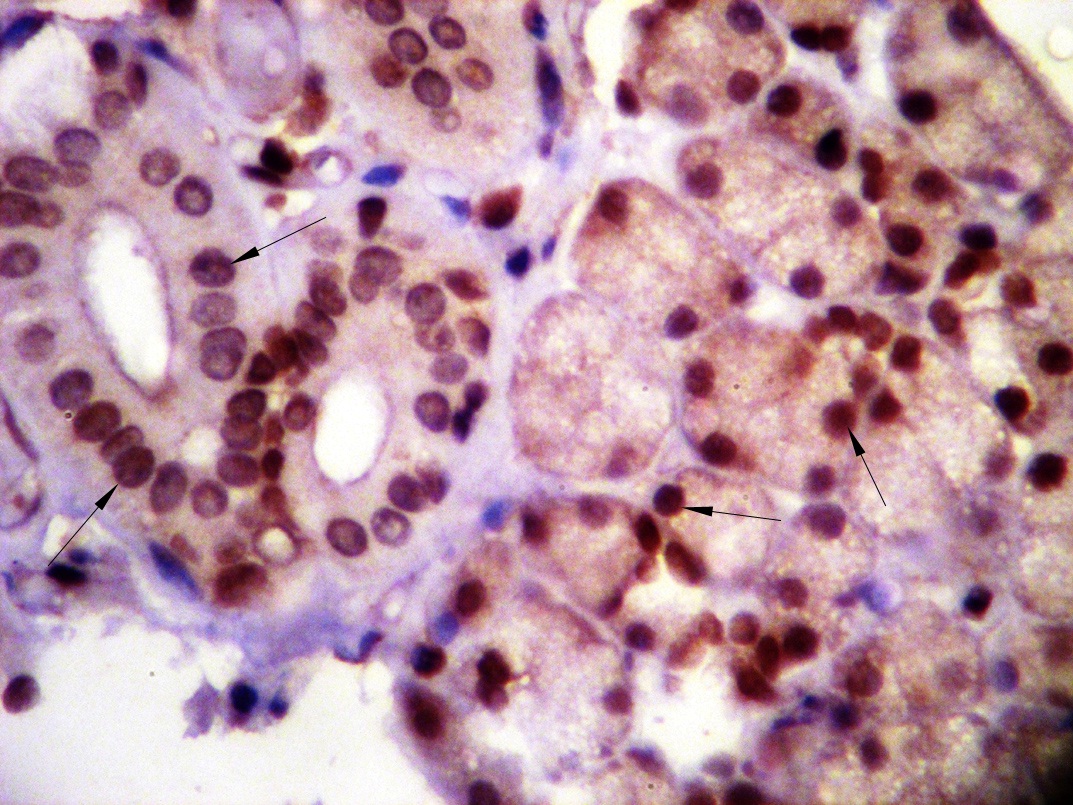
Negative - Complete absence of nuclear staining of the cells for p27.
Weakly positive - Less than 25% of the cells showing nuclear staining with p27 in the selected zone.
Moderately positive - 25%-75% of the cells in the selected zone showing nuclear staining with p27.
Strong positivity- More than 75% of the cells in the selected area showing nuclear staining with p27 (The pathologists in the present study used the criteria followed in the study done by Bassel Tarakji on expression of Retinoblastoma protein (pRb) in pleomorphic adenoma and carcinoma ex pleomorphic adenoma [6].
Simple arithmetic calculations were used to evaluate the percentage of the cases with various expressions as the number of variables was limited.
The percentage wise distribution of weak, moderate and strong positivity of the sections was compared within the same tumor and also between the tumor groups.
Results
The mean of the observations of the two pathologists was calculated and the following results were obtained.
Out of 19 pleomorphic adenoma cases, 10 cases (52.6%) exhibited strong positivity for p27; five cases (26.4%) cases expressed moderate positivity whereas four cases (21%) expressed weak positivity for p27 antibody [Table/Fig-3].
Depicting the expression of p27 in pleomorphic adenoma cases1- Strong expression, 2-Moderate expression, 3- Weak expression.
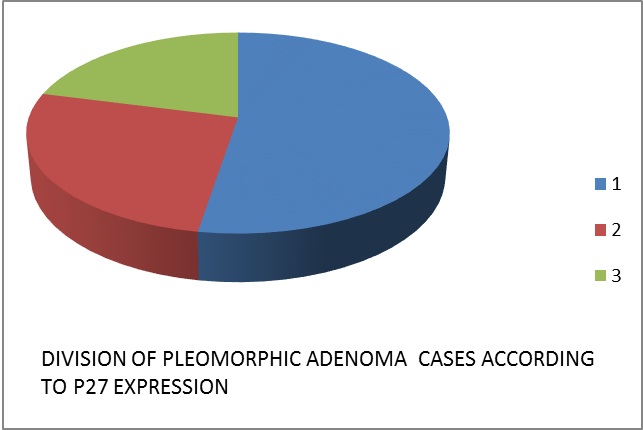
Among the eight cases of mucoepidermoid carcinoma studied, two cases (25%) have shown strong positivity while moderate and weak positivity was seen in three cases (37.5%) each [Table/Fig-4].
Depicting the expression of p27 in mucoepidermoid carcinoma cases1- Strong expression, 2-Moderate expression, 3- Weak expression.
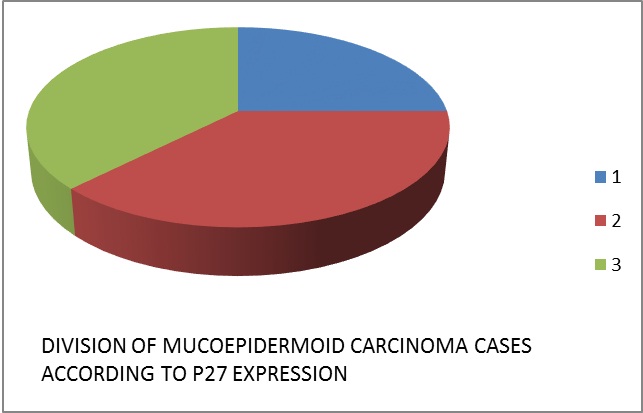
Only one case (14.2%) of adenoid cystic carcinoma expressed strong positivity whereas three cases each (42.8%) have shown moderate and weak positivity out of total of seven cases [Table/Fig-5].
Depicting the expression of p27 in adenoid cystic carcinoma cases.
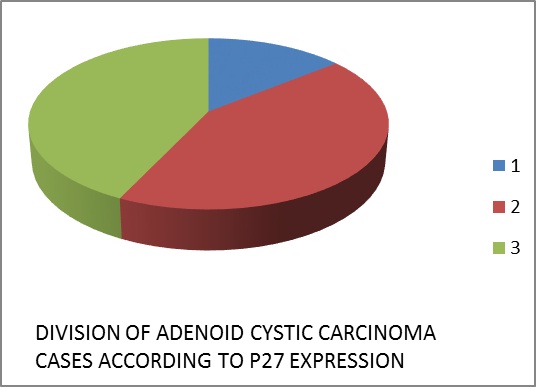
Discussion
Reduced expression of a cyclin-dependent kinase inhibitor, p27 has been reported to be associated with poor prognosis in several human cancers [7]. Strong and moderate expression of p27 was seen in significant number of cases of pleomorphic adenomas in the present study (52.6% and 26.4% respectively) [Table/Fig-6]. Conventionally, the expression of p27 is known to be strong in normal glandular tissues. Malignant change in a tissue is known to be associated with reduced expression of p27 [4–6]. Hence, since pleomorphic adenoma is a benign neoplasm with excellent prognosis, the strong expression of p27 in this group of tumors can be attributed to the benign nature of the neoplasm. Only four cases (21%) of pleomorphic adenomas expressed weak expression further justifying the hypothesis. The results of the present study with respect to pleomorphic adenomas are in accordance with the results of the study conducted by Shahsavari F et al., which found high expression of p27 in pleomorphic adenomas [8]. The above mentioned study was conducted on neoplasms involving only the minor salivary glands. Present study included neoplasms involving both major and minor glands. Strongly similar findings were derived in the study conducted by Ito R et al., who compared expression of p27 in oral malignancies with that in pleomorphic adenomas where the latter exhibited strong expression [9]. Among the four cases which expressed weak positivity for p27, three cases were classified as predominantly cellular type (Foot and Frazell histologic classification of pleomorphic adenomas) [1]. The other was classified as type II (myxoid and cellular components in equal proportions). The correlation between histologic subtypes and prognosis in case of pleomorphic adenomas still remains unresolved [1]. Although one study suggests lack of correlation between degree of expression of p27 and histologic variations in pleomorphic adenoma [10]. Studies with large sample size aimed at defining this correlation can possibly explain the low expression of p27 in predominantly cellular type of pleomorphic adenomas.
Cell rich focus of pleomorphic adenoma admixed with secretions showing strong expression of p27 with the neoplastic cells.
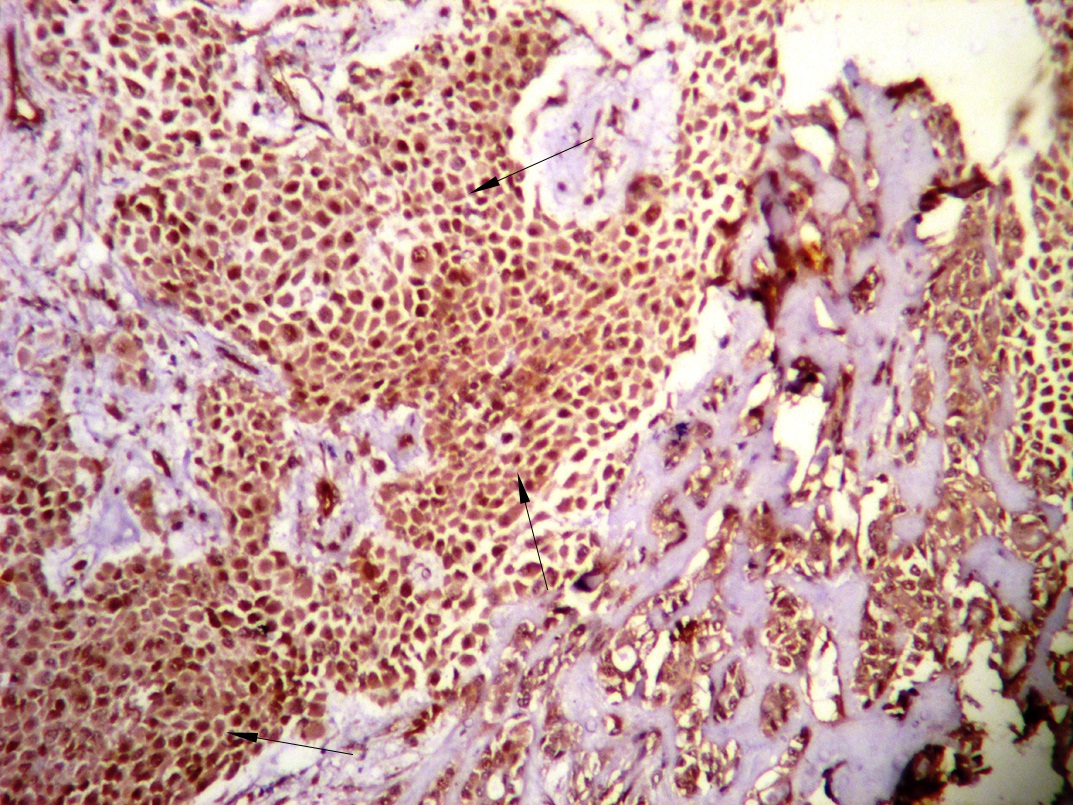
Mucoepidermoid carcinoma being the commonest salivary gland malignancy was selected for the study along with pleomorphic adenoma and adenoid cystic carcinoma [1]. Three cases (37.5%) of mucoepidermoid carcinoma out of eight selected for this study have shown weak expression of p27 while other 37.5% showed moderate expression [Table/Fig-7]. The cases with weak expression consisted predominantly of solid areas of epidermoid cells with focal mucous cell distribution. In a study done by Ito R et al., 95% of the mucoepidermoid carcinoma cases showed reduced expression of p27 and the expression of p27 had an inverse relation with expression of Cyclin E [9]. Two cases strongly expressed p27 which amounts to 25% of the cases which is in contradiction to the above mentioned study [Table/Fig-8]. The two cases showing strong expression comprised of one intermediate grade and one low grade tumor. The difference can be attributed to the type of antibody used as well to the difference in the technique used for staining as well as evaluation of the slides. Akrish S et al., conducted a similar study by segregating the malignant salivary gland tumor cases depending upon their histogenesis in which the tumors suggested to have originated from intercalated duct apparatus showed strong expression of p27 and skp2 [11]. This could possibly explain the strong expression in two mucoepidermoid carcinoma cases. The intercalated duct origin histogenesis concept for pleomorphic adenoma and mucoepidermoid carcinoma proposed by Dardick [1] can be used as a platform to understand the strong positive expression of p27 in pleomorphic adenomas and mucoepidermoid cases [12,13]. Seven adenoid cystic carcinoma cases were part of this study since this tumor is not as common as pleomorphic adenoma and less common than mucoepidermoid carcinomas. Only one case (14.2%) showed strong positivity in the present study. Significant number of cases (42.8% each) expressed weak and moderate positivity [Table/Fig-9]. The solitary case that showed strong positivity was a cribriform histologic variant of adenoid cystic carcinoma [Table/Fig-10]. Three cases with weak positivity consisted of one case exhibiting a combination of tubular and solid pattern while the other two showed solid pattern uniformly. The overall findings of the present study are similar to the findings of the study conducted by Shahsavari F et al., which suggested that p27 might be an important factor in the development and malignant behaviour of adenoid cystic carcinoma [8]. A study conducted by Affolter A et al., showed complete loss of expression of p27 in 78% of the studied adenoid cystic carcinoma cases [14]. Total 83% of the adenoid cystic carcinomas have shown reduced expression of p27 in a study conducted by Takata et al., who suggest a significant role of p27 in the development of adenoid cystic carcinoma as well as in its prognosis [15]. Another correlation that needs to be elaborately discussed and studied is the histogenesis of the neoplasms and their prognostic significance in the light of p27 expression. The proposed origin of cribriform variant of adenoid cystic carcinoma is same as that of pleomorphic adenoma [16, 17]. Considering the small sample size in the present study as well as in other previous studies, it would be premature to comment with certainty about the role of p27 in pathogenesis of adenoid cystic carcinoma. Further studies with larger sample size involving multiple CDKs and CDKIs should be conducted [18]. Retrieval of complete clinical data regarding all the cases was not possible as few cases did not turn up for the follow-up. Therefore determination of prognosis and subsequently, establishing correlation between prognosis and p27 expression was difficult.
Mucoepidermoid carcinoma showing moderate expression of p27.
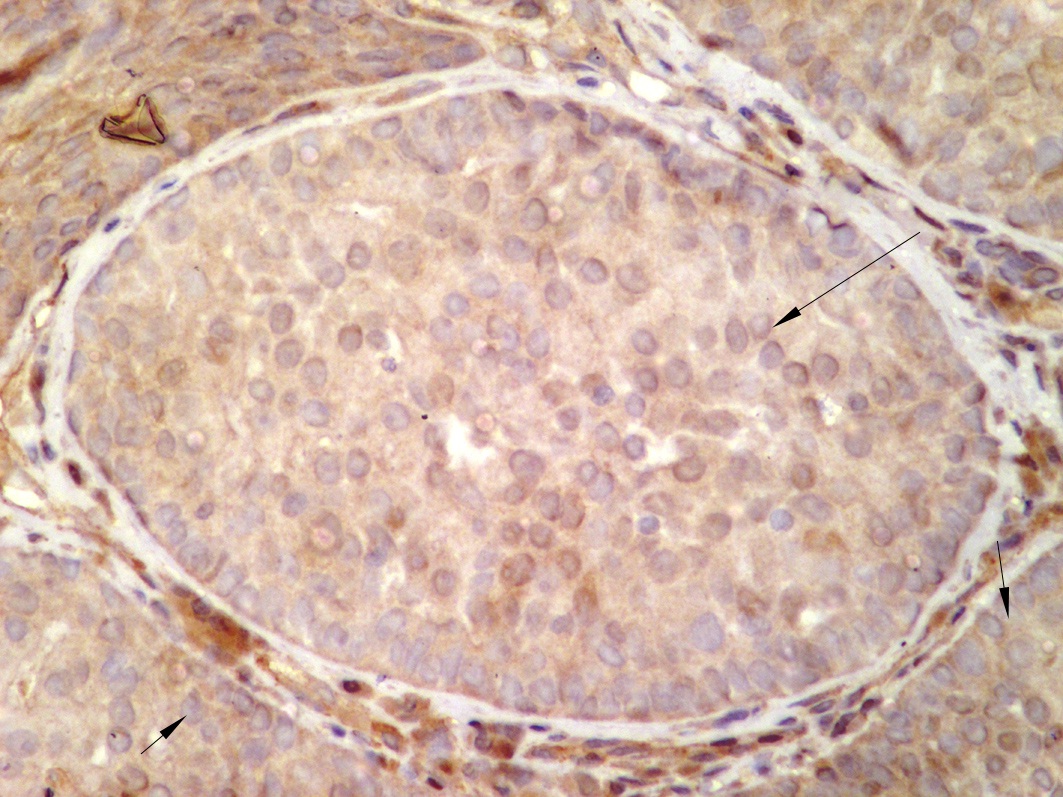
Epidermoid cells in mucoepidermoid carcinoma showing strong expression for p27.
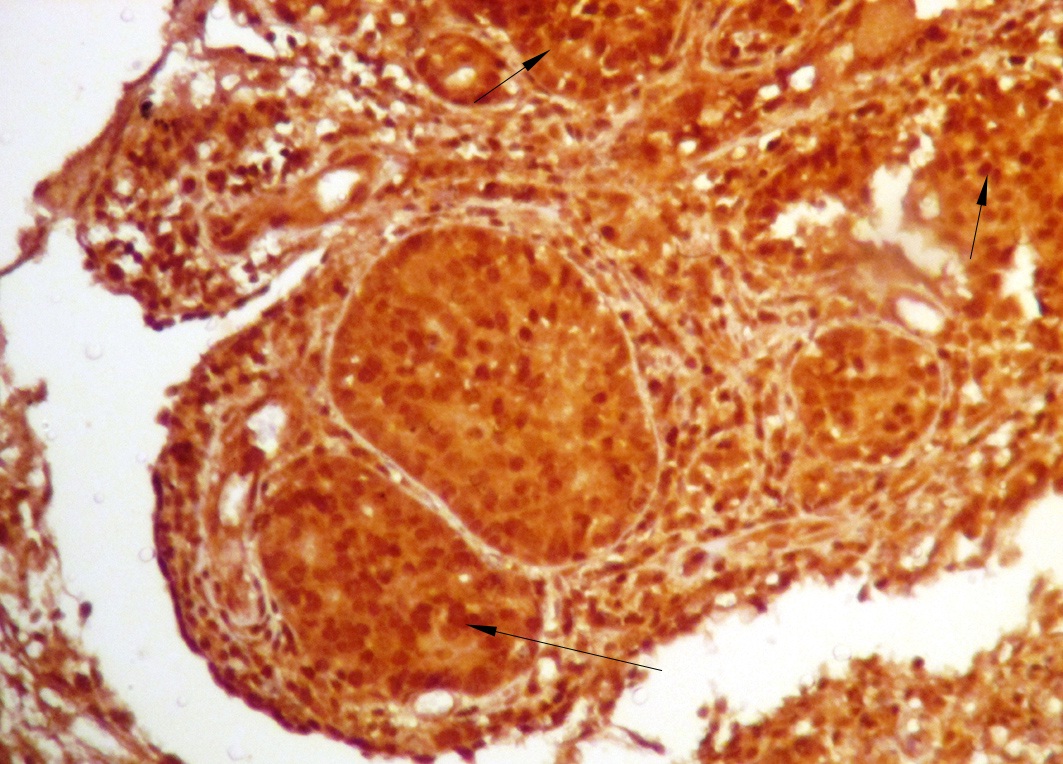
Adenoid cystic carcinoma showing weak expression of p27.
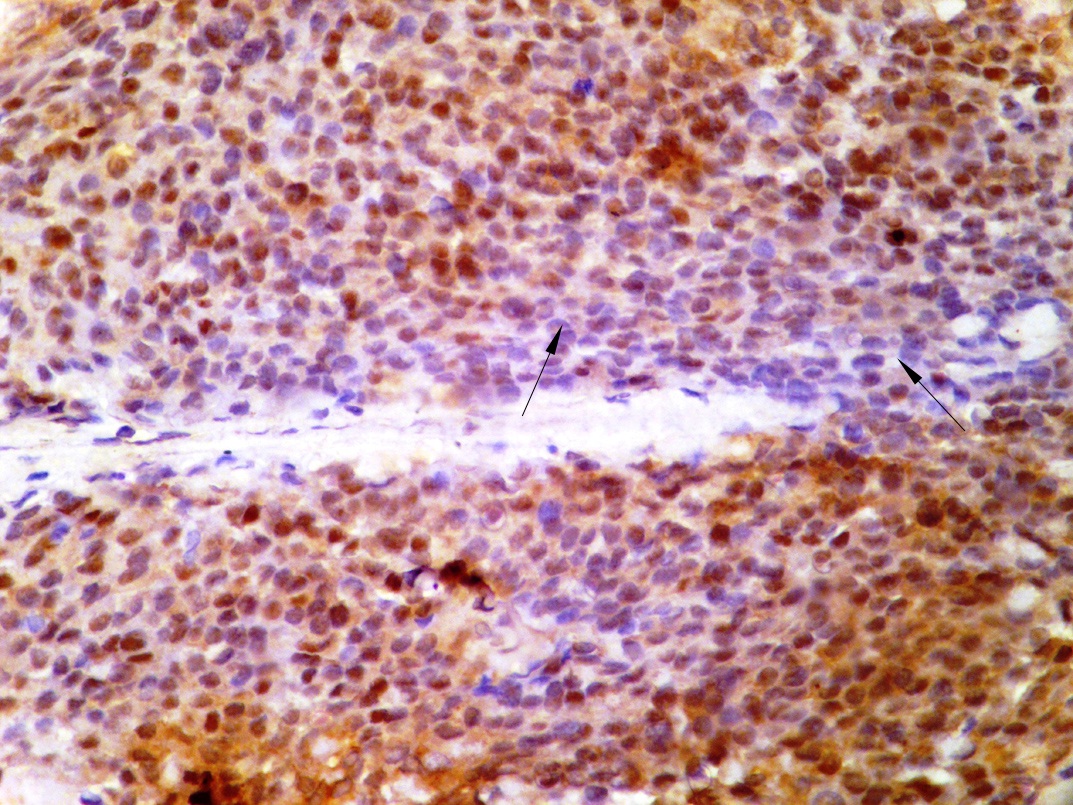
Cribriform variant of adenoid cystic carcinoma showing strong positivity for p27.
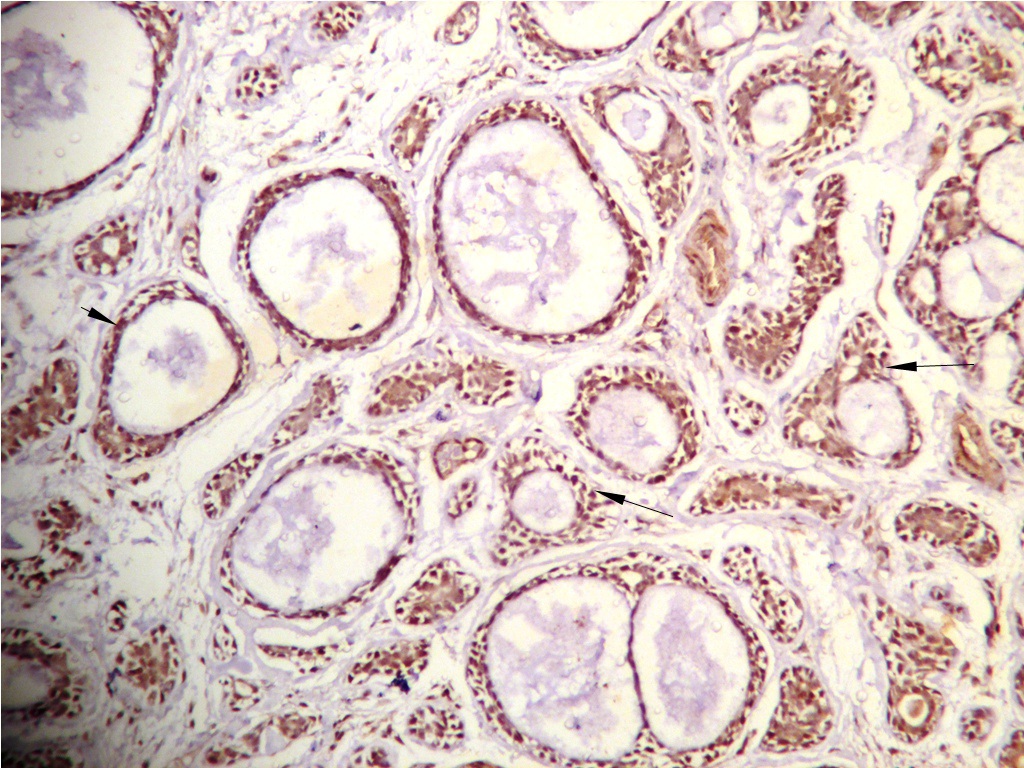
Conclusion
The present study suggests a minor role of p27 in pathogenesis of pleomorphic adenoma. The reduced expression in the malignant tumours suggests a significant role of p27 in mucoepidermoid carcinoma and adenoid cystic carcinoma although PCR studies would give a clear picture of pathogenesis of these tumors with respect to the role of CDKs and CDKIs. This study although does not have direct clinical implications, it is a building block for the establishment of a correlation between p27 expression, histologic variation and prognosis of salivary gland tumors which can influence the treatment in the coming years.
PA - Pleomorphic Adenoma, MEC- Muco Epidermoid CarcinomaACC - Adenoid Cystic Carcinoma
[1]. Ellis GL, Surgical pathology of salivary glands Major problems in pathology (volume 25) W. B. Saunders Company [Google Scholar]
[2]. Robbins Cotrans Pathologic basis of disease Seventh editionElsevier Inc [Google Scholar]
[3]. Wang Y, Yu YN, Song S, Li TJ, Xiang JY, Xang H, JAB1 and phospho-Ser10 p27 expression profile determine human hepatocellular carcinoma prognosis J Cancer Res Clin Oncol 2014 140(6):969-78. [Google Scholar]
[4]. Gayed BA, Youssef RF, Bagrodia A, Kapur P, Darwish OM, Krabbe LM, Prognostic role of cell cycle and proliferative biomarkers in patients with clear cell renal cell carcinoma J Urol 2013 190(5):1662-67. [Google Scholar]
[5]. Gao L, Gu W, Zheng J, Ren W, Chang S, Wang X, Clinicopathological and prognostic significance of p27 expression in oral squamous cell carcinoma. A meta analysis Int J Biol Markers 2013 28(4):e392-35. [Google Scholar]
[6]. Tarakji B, Immunohistochemical expression of pRb in pleomorphic adenoma and carcinoma ex pleomorphic adenoma Med Oral Patol Oral Cir Bucal 2011 16(3):e323-29. [Google Scholar]
[7]. Shigemasa K, Shiroyama Y, Sawasaki T, Fujii T, Nagai N, Parmley TH, Under expression of cyclin-dependent kinase inhibitor p27 is associated with poor prognosis in serous ovarian carcinomas Int J Oncol 200 18(5):953-58. [Google Scholar]
[8]. Shahsavari F, Eslami M, Baghaie F, Tirgari F, Motahhary P, Immunohistochemical evaluation of p27 in pleomorphic adenomas and adenoid cystic carcinomas of the minor salivary glands Asian Pac J Cancer Prev 2005 6(4):527-30. [Google Scholar]
[9]. Ito R, Yasui W, Oqawa Y, Toyosawa S, Tahara E, Ijuhin N, Reduced expression of cyclin-dependent kinase inhibitor p27(Kip1) in oral malignant tumors Pathobiol 1999 67(4):169-73. [Google Scholar]
[10]. Rullo R, Festa VM, Accardo M, Ferraracio F, The immunohistochemical outline of p27kip1, cyclin B1 and cyclin D3 in pleomorphic adenomas Minerva Stomatol 2006 55(9):483-92. [Google Scholar]
[11]. Akrish S, Ben-Izhak O, Peled M, P27/SKP-2 histochemical profile is relevant to malignant salivary gland tumors (MST) histogenesis and tumor grade Head Neck Pathol 2012 6(2):157-65. [Google Scholar]
[12]. Dardick I, Gliniecki M, Heathcote J, Burford-Mason A, Comparative histogenesis and morphogenesis of mucoepidermoid carcinoma and pleomorphic adenoma. An ultrastructural study Virchows Arch A Pathol Anat Histopathol 1990 417:405-17. [Google Scholar]
[13]. Erlandson R, Cardon-Cardo C, Higgins P, Histogenesis of benign pleomorphic adenoma (mixed tumor) of the major salivary glands. An ultrastructural and immunohistochemical study Am J Surg Pathol 1984 8:803-20. [Google Scholar]
[14]. Affolter A, Helmbrecht S, Finger S, Hormann K, Gotte K, Altered expression of cell cycle regulators P21 P27 and P53in tumors of salivary glands and paranasal sinuses Oncol Rep 2005 13(6):1089-94. [Google Scholar]
[15]. Takata T, Kudo Y, Zhao M, Ogawa I, Miyauchi M, Sato S, Reduced expression of p27 (Kip1) protein in relation to salivary adenoid cystic carcinoma metastasis Cancer 1999 86(6):928-35. [Google Scholar]
[16]. Dardick I, Von Nostrand AW, Morphogenesis of salivary gland tumours. A prerequisite to improving classification Pathol Annu 1987 22:1-53. [Google Scholar]
[17]. Orenstein JM, Dardick I, Van Norstrand AW, Ultrastructural similarities of adenoid cystic carcinoma and pleomorphic adenoma Histopathology 1985 9(6):623-38. [Google Scholar]
[18]. Daa T, Aberrant methylation in promoter regions of cyclin-dependent kinase inhibitor genes in adenoid cystic carcinoma of the salivary gland APMIS 2008 116(1):21-26. [Google Scholar]